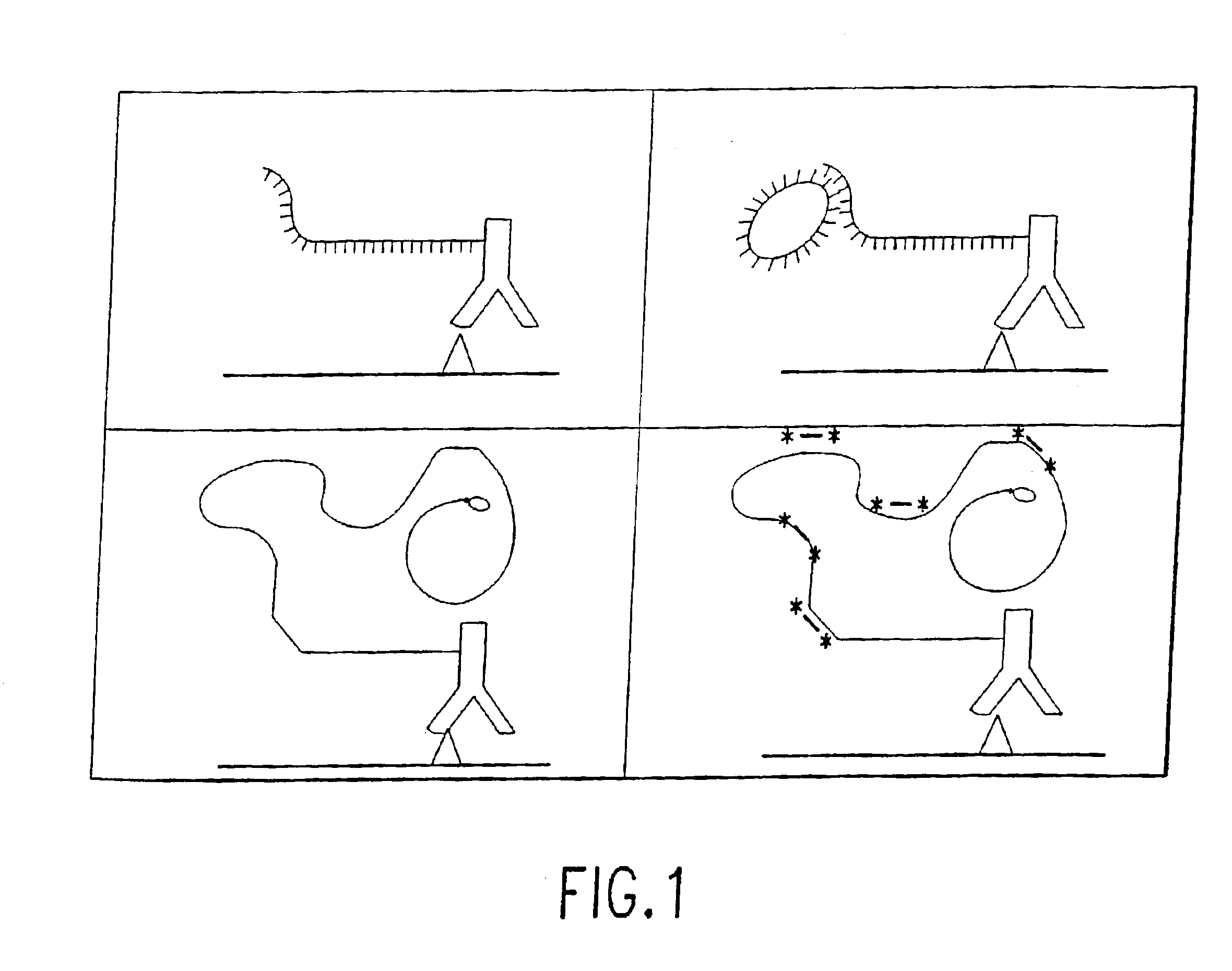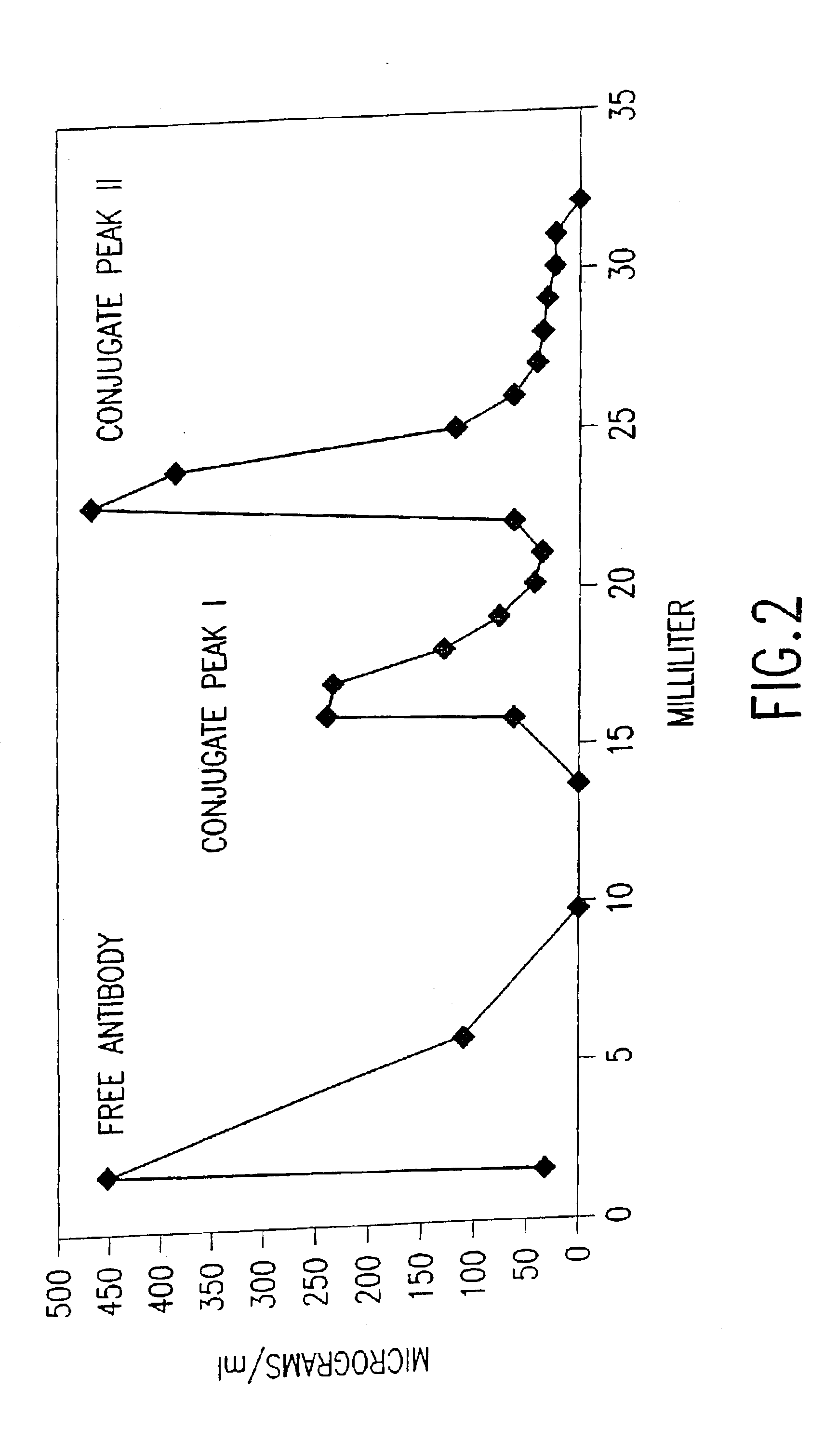Protein expression profiling
a protein and expression technology, applied in the field of protein expression profiling, can solve the problems of large production of dna and large amount of nucleic acid from each primer, and achieve the effect of being detectabl
- Summary
- Abstract
- Description
- Claims
- Application Information
AI Technical Summary
Benefits of technology
Problems solved by technology
Method used
Image
Examples
example 1
A. Example 1
[0164]This example demonstrates the construction and characterization of antibody-DNA conjugates that are used as Reporter Binding Primers.
[0165]Oligonucleotides. All oligonucleotides used were synthesized on a Perseptive Biosystems Expedite DNA Synthesizer and purified by reverse-phase HPLC. Circle DNAs were constructed as previously described (4). Conjugate Rolling Circle Replication primer: 5′ Thiol-GTA CCA TCA TAT ATG TCC GTG CTA GAA GGA AAC AGT TAC A-3′ (SEQ ID NO:1); Amplification Target Circle DNA: 5′-TAG CAC GGA CAT ATA TGA TGG TAC CGC AGT ATG AGT ATC TCC TAT CAC TAC TAA GTG GAA GAA ATG TAA CTG TTT CCT TC-3′ (SEQ ID NO:2); Detection Probes-5′ Cy3 TAT ATG ATG GTA CCG CAG Cy3 3′ (SEQ ID NO:3), 5′ Cy3 TGA GTA TCT CCT ATG ACT Cy3 3′ (SEQ ID NO:4), 5′ Cy3 TAA GTG GAA GAA ATG TAA Cy3 3′ (SEQ ID NO:5).
[0166]Antibody-DNA conjugation. Antibody was buffer-exchanged into 50 mM NaPhosphate pH 7.5, 150 mM NaCl, 1 mM EDTA by chromatography over a PD-10 column (Amersham-Pharmac...
example 2
B. Example 2
[0169]This example demonstrates the use of a Reporter Antibody Primer / Antibody-DNA conjugate for detection of an analyte in an ELISA format. Detection by ImmunoRCA is shown to have superior sensitivity and dynamic range when compared to detection using a conventional antibody-enzyme conjugate.
[0170]ELISA assay. Ninety-six well plates (Nunc Maxisorb) were incubated with 100 μl 2 μg / ml goat polyclonal anti-human IgE per well for 2 hours at 37° C. and then overnight at 4° C. Plates were washed three times with 100 μl TBS / 0.05% Tween 20, and then blocked with 5% non-fat dry milk for 2 hours at 37° C. Plates were washed again with TBS / 0.05% Tween 20, followed by addition of the IgE analyte at variable concentrations in a 100 μl volume. After a 37° C. incubation for 30 min., plates were washed three times with 100 μl TBS / 0.05% Tween 20. In the conventional ELISA assays, anti-human IgE-alkaline phosphatase conjugate was added to each well, and incubated at 37° C. for 30 min. Af...
example 3
C. Example 3
[0171]This example demonstrates the use of a Reporter Antibody Primer / Antibody-DNA conjugate for detection of an analyte in a microparticle format. Human IgE was again selected as the test analyte, but this sandwich assay was performed using avidin-coated magnetic microparticles and biotinylated polyclonal anti-human IgE capture antibodies. Briefly, streptavidin-coated magnetic beads (Bangs Laboratories) were coated with a solution of 16 μg / ml biotinylated polyclonal anti-human IgE (Pharmingen) in TBS, washed three times in TBS / 0.05% Tween 20, and blocked overnight with 2 mg / ml BSA. Beads were incubated with human IgE (25 ng / ml) in TBS for 20 min. at room temperature, and washed three times in TBS / 0.05% Tween 20. Detection of IgE using a conventional anti-IgE-alkaline phosphatase conjugate or an immunoRCA conjugate was carried out as described above for the ELISA assay. In FIG. 7, it can be seen that immunoRCA with the anti-IgE-DNA conjugate gave a strong signal with a m...
PUM
| Property | Measurement | Unit |
|---|---|---|
| volumes | aaaaa | aaaaa |
| pH | aaaaa | aaaaa |
| pH | aaaaa | aaaaa |
Abstract
Description
Claims
Application Information
 Login to View More
Login to View More - R&D
- Intellectual Property
- Life Sciences
- Materials
- Tech Scout
- Unparalleled Data Quality
- Higher Quality Content
- 60% Fewer Hallucinations
Browse by: Latest US Patents, China's latest patents, Technical Efficacy Thesaurus, Application Domain, Technology Topic, Popular Technical Reports.
© 2025 PatSnap. All rights reserved.Legal|Privacy policy|Modern Slavery Act Transparency Statement|Sitemap|About US| Contact US: help@patsnap.com



